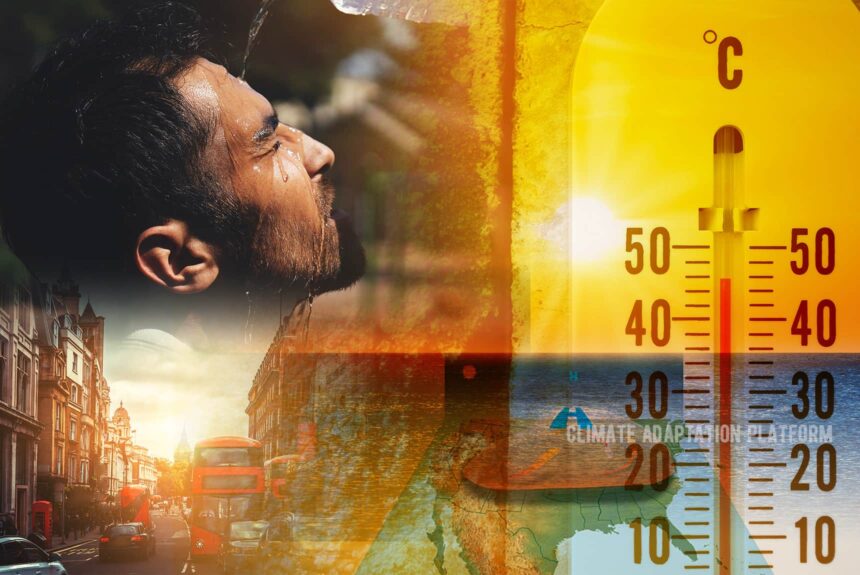As the earth’s temperatures rise, heat waves become more frequent and severe, posing serious health risks.
Last year, in the summer of 2021, the record-breaking heatwave in the U.S. Pacific Northwest killed hundreds of people.
From late April to May of this year, parts of India and Pakistan have been sweltering for a week under unprecedented heat waves that exposed more than a billion people to fatally high temperatures.
Severe heatwaves caused by climate change can also increase the wet-bulb temperatures, “an esoteric measurement that was little known outside meteorology circles until now that experts believe could threaten the ability of humans to survive” (Chow, 2022).
Wet-bulb temperatures are becoming an urgent concern as climate change is making heat waves more frequent and more severe, making heat events unsurvivable.
What is wet bulb temperature?
Wet-bulb temperature measures the combination of heat and humidity. When this reaches 36°C or around the same as the human body temperature, it hinders the body its ability to cool itself through sweating because, at a web bulb temperature of about 35°C to 36°C, moisture saturates humid air that even when the body sweats it no longer evaporates and sweating no longer has the ability to cool our bodies.
Tapio Schneider, a professor of environmental science and engineering at the California Institute of Technology, says that sweating is a very effective means of cooling, however, it is crucial that sweat can evaporate (Chow, 2022).
The term wet-bulb came from the first time it was measured using a damp cloth wrapped around the bulb of a thermometer and exposed to air.
Buis (2022) says, “As the water evaporated from the cloth, the thermometer recorded the drop in temperature. The higher the relative humidity, the less moisture evaporated before the bulb and the surrounding air are at the same temperature.”
But today, wet-bulb temperature is typically calculated using measurements from electronic instruments at weather stations, the article says.
When it comes to the highest wet-bulb temperature that humans can survive, Colin Raymond of NASA’s Jet Propulsion Laboratory in Southern California says that it is about 95 degrees Fahrenheit (35 degrees Celsius) when exposed to the elements for at least six hours.
But even at slightly lower wet-bulb temperatures at 32°C is still risky for any human activity such as walking or working outside (The increasing frequency, 2022).
The increasing frequency (2022) explains:
- This temperature was reached in Chennai, India, on May 1 this year. The thresholds could still be lower for the elderly or people with medical conditions.
- The United States National Weather Service considers wet-bulb temperatures of around 31°C to constitute “extreme danger”.
The article says that in 2015, 4000 people died in Pakistan due to a brief wet-bulb temperature of 30°C. Similarly, the heat dome in America’s Pacific north-west in 2021 killed around 200 people at a wet-bulb of about 25°C.
These excerpts from the Science Advances’ article, “The emergence of heat and humidity too severe for human tolerance” explains further:
- Heat and humidity in part of South Asia, including India and Pakistan, coastal and southwestern North America and areas around the Persian Gulf are already pushing human survivability to the limits, this is the findings of the study published in May 2020.
- The study finds that temperatures in these regions are “nearing or beyond prolonged human physiological tolerance.”
According to NASA, satellites can now detect wet-bulb hotspots around the globe. These satellites will be particularly helpful in developing countries in the subtropics without sufficient and reliable long-term weather stations (Buis, 2022).
“Instruments in space like the Atmospheric Infrared Sounder (AIRS) on NASA’s Aqua satellite and the ECOsystem Spaceborne Thermal Radiometer Experiment (ECOSTRESS) on the International Space Station (ISS) provide useful data for studying heat stress” (Buis, 2022).
The article says that these new tools can also help provide the necessary data to calculate a more advanced heat stress metric, called the wet bulb globe temperature.
Raymond from NASA explains that it is quite difficult to predict when wet-bulb temperature happens, but climate models are showing that the regions that will likely exceed 35°C in the next 30-50 years include South Asia, the Persian Gulf, and the Red Sea by around 2050; and Eastern China, parts of Southeast Asia, and Brazil by 2070 (Buis, 2022).
Mitigating Wet Bulb temperatures
Friederike Otto, a climate scientist at Imperial College London, says that oppressive and dangerous heat waves will persist without crucial interventions to reduce greenhouse gas emissions and slow the pace of climate change (Chow, 2022).
“We have seen everywhere across the world that heat records are being broken every year, and this is exactly what we expect in a warming climate. Climate change has been a real game-changer when it comes to heat waves, Otto adds.
Sources:
Chow, D. (2022, May 7). Deadly ‘wet-bulb temperatures’ are being stoked by climate change and heat waves. NBC News. Retrieved from https://www.nbcnews.com/science/science-news/wet-bulb-temperature-weather-average-climate-human-heat-wave-rcna27478
Buis, A. (2022, March 9). Too Hot to Handle: How Climate Change May Make Some Places Too Hot to Live. NASA. Retrieved from https://climate.nasa.gov/ask-nasa-climate/3151/too-hot-to-handle-how-climate-change-may-make-some-places-too-hot-to-live/
The increasing frequency of fatal wet-bulb temperatures. (2022 May 13). The Economist. Retrieved from https://www.economist.com/the-economist-explains/2022/05/13/the-increasing-frequency-of-fatal-wet-bulb-temperatures?
Raymond C., Matthews, T. & Horton, R. (2020 May 8). The emergence of heat and humidity too severe for human tolerance. Science Advances. Retrieved from https://www.science.org/doi/10.1126/sciadv.aaw1838



Leave a Reply